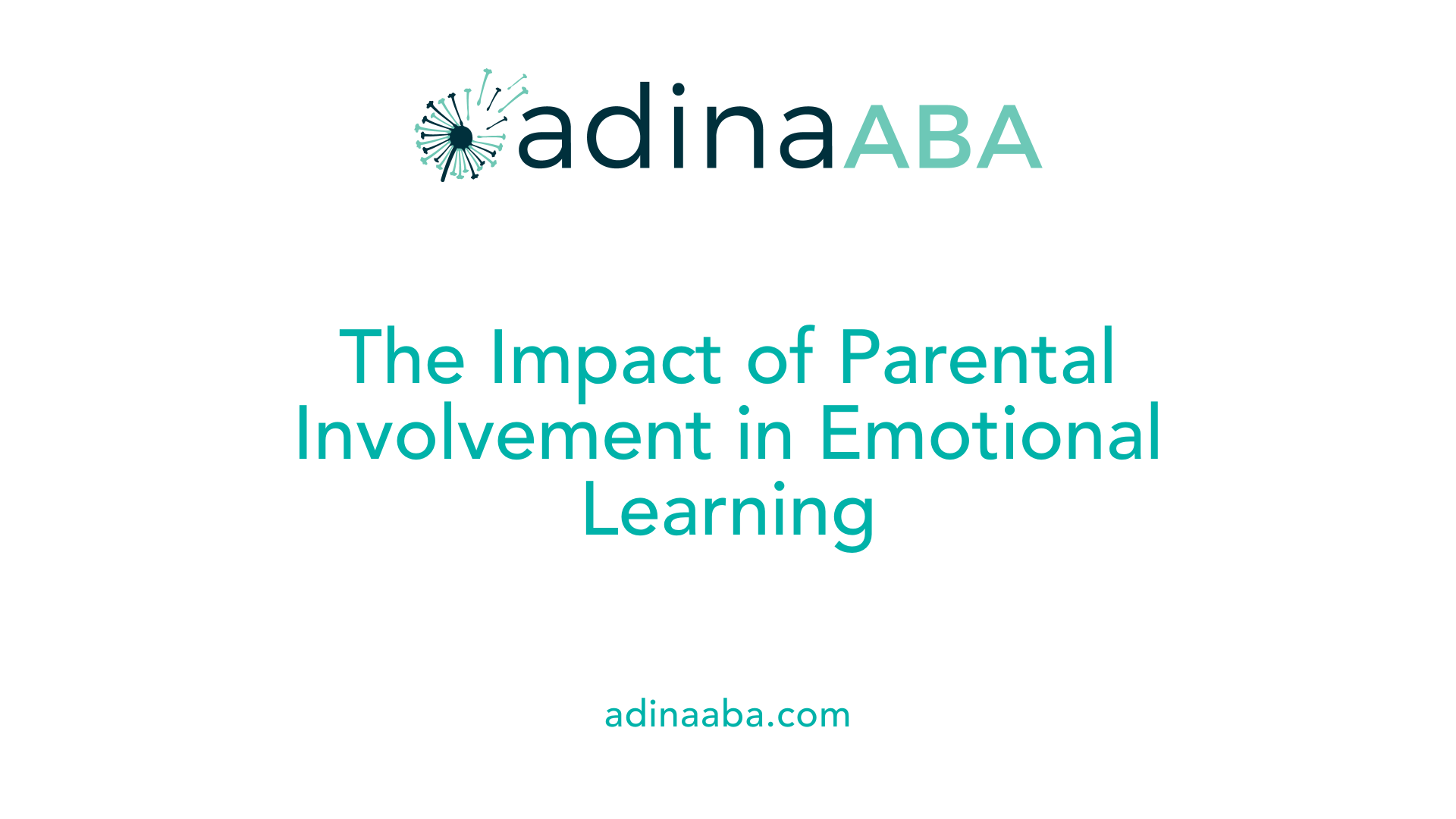How to Support Your Child’s Emotional Regulation Using ABA

Understanding Emotional Regulation and ABA
Emotional regulation is an essential skill that allows children to manage their emotions effectively, helping them navigate daily interactions and challenges. This ability is particularly crucial for children with Autism Spectrum Disorder (ASD), who often encounter unique challenges in identifying and expressing their feelings. Applied Behavior Analysis (ABA) offers a structured, evidence-based approach to fostering emotional and social development in children. This article explores various strategies and techniques using ABA to support your child's emotional regulation journey.
Effective Strategies for Emotion Management

What are some effective strategies and techniques for helping children manage their emotions?
Effective strategies for helping children manage their emotions encompass several key practices that contribute to a supportive environment. One fundamental approach is teaching children to identify and label their feelings. This process is best done during calm moments, enabling children to articulate their emotions rather than in the heat of an emotional outburst. By acknowledging and understanding their feelings, children start to realize that emotions are a natural part of life.
Moreover, modeling appropriate emotional responses is crucial. Caregivers should maintain their composure when a child faces emotional difficulties. Demonstrating how to respond to stress or frustration calmly sets a powerful example. This practice can enhance the child's ability to mimic healthy emotional expressions.
How can collaboration with educators bolster emotional management?
Collaboration with educators contributes to consistent emotional support for children. By working together, parents and teachers can share insights and strategies, ensuring that emotional regulation techniques are reinforced in both home and school settings. This continuity helps children feel secure and supported.
What role do mindfulness and coping strategies play in emotional regulation?
Mindfulness and coping strategies play a pivotal role in helping children regulate their emotions. Techniques such as deep breathing exercises and simple mindfulness practices encourage children to focus on the present, reducing anxiety and enhancing emotional clarity. Parents can introduce these techniques as part of everyday routines, making them accessible during stressful situations.
By weaving together these strategies, caregivers can foster a nurturing environment that promotes emotional growth and resilience in children.
The Power of Parental Involvement

Why is parental involvement important in teaching emotional regulation skills to children?
Parental involvement plays a crucial role in imparting emotional regulation skills to children. Parents are often the primary role models for emotional responses and behaviors, making their influence significant in shaping how children understand and manage their emotions. When parents actively demonstrate emotional regulation through their own actions, they provide a framework for children to learn these essential skills.
Role modeling by parents
Role modeling is a powerful teaching tool. When parents openly express their emotions and demonstrate coping strategies, they teach children not only how to label their emotions but also how to manage them effectively. This modeling creates an environment where children feel safe to explore and express their feelings.
Creating a supportive emotional climate at home
A supportive emotional climate at home is vital for children's emotional development. This climate is built on healthy attachments and effective parenting strategies, which help foster emotional literacy and resilience. When children grow up in an environment that nurtures their emotional needs, they are more likely to develop strong self-regulation skills.
Co-regulation opportunities
Co-regulation opportunities arise during moments of emotional outbursts or stress. Parents can help children navigate these situations without overwhelming them. Encouraging the use of calm-down techniques, such as deep breathing, supports children's independence in managing their emotions. This emotional support not only strengthens family bonds but also equips children with the skills they need to cope with their feelings in a positive way.
Challenges for Children with ASD and Interventions

What challenges do children with autism face in emotional regulation and what interventions can help overcome these challenges?
Children with Autism Spectrum Disorder (ASD) encounter specific hurdles in emotional regulation. These challenges often stem from difficulties in recognizing and expressing their emotions, leading to behavioral issues such as tantrums, aggression, or self-injury. One significant factor is alexithymia, the struggle to identify and articulate feelings, which hampers effective emotional management.
Moreover, deficits in perspective-taking, a critical aspect of emotional understanding, further complicate their ability to regulate emotions. Children with ASD may misinterpret social cues or struggle to gauge their emotional states accurately. This lack of recognition can lead to inappropriate responses during stressful situations or overstimulation.
To address these challenges, interventions like Cognitive-Behavioral Therapy (CBT) have emerged as effective tools. CBT focuses on teaching children to develop emotional awareness and coping strategies. Programs such as the Exploring Feelings initiative specifically target emotional understanding and help children identify early signs of distress, enhancing their capacity to manage strong emotions.
Additionally, mindfulness approaches and acceptance-based strategies provide valuable skills in reducing emotional suppression while promoting adaptive emotional regulation. By practicing mindfulness, children learn to stay present, which aids in managing their feelings more effectively. Through these tailored interventions, children with ASD can improve both their emotional regulation abilities and social skills, enhancing their overall quality of life.
Adapting Emotional Regulation Methods with ABA for ASD

How can emotional regulation methods be adapted for children with autism spectrum disorder using Applied Behavior Analysis?
Emotional regulation methods for children with autism spectrum disorder (ASD) can be effectively adapted using Applied Behavior Analysis (ABA) by emphasizing core impairments in emotional regulation. Understanding that many emotional outbursts stem from stress or overstimulation rather than defiance is crucial for effective intervention.
A structured approach helps identify emotional triggers and modify environments to lessen anxiety. Techniques are tailored to meet individual needs, ensuring that children feel equipped to manage their emotions. For instance, incorporating tools like The Incredible Five Point Scale promotes self-awareness by allowing children to identify and communicate their emotions.
What is the role of the 5-point scale and self-awareness?
The 5-point scale can be a game-changer for enhancing self-awareness in children with ASD. By breaking down emotions into graded levels, it helps children articulate their feelings more clearly. This visual strategy simplifies complex emotional states into relatable increments, fostering better emotional communication.
Additionally, implementing task analysis when teaching coping strategies, such as deep breathing and counting, enables children to practice these skills in manageable steps. This method not only makes the learning process less overwhelming but also enhances retention of the techniques over time.
How do Functional Behavior Assessments (FBA) contribute to emotional regulation interventions?
Functional Behavior Assessments (FBA) play a critical role in guiding tailored interventions. By examining the context and reasons behind emotional dysregulation, professionals can design specific approaches that target the unique challenges faced by each child. This understanding allows practitioners to focus on preventative strategies that address the root causes of emotional disturbances rather than merely treating symptoms.
In summary, using ABA techniques, such as structured assessments and visual aids, supports the development of emotional self-regulation in children with ASD. This integrated approach aims to improve their daily functioning and overall quality of life.
Practical Tips for Teaching Emotional Regulation

What practical tips can parents, educators, or clinicians use for teaching emotional regulation to children?
To teach emotional regulation to children, effective strategies are essential. Here are key methods:
Modeling Emotional Responses
- Parents and caregivers should demonstrate healthy emotional responses. When adults manage their feelings appropriately, children are more likely to imitate these behaviors, learning to navigate their own emotions.
Mindfulness Practices
- Incorporating mindfulness exercises can significantly bolster emotional regulation. Techniques such as deep breathing, squeezing hands, or even engaging in activities like blowing bubbles encourage children to focus on the present and manage stress. These practices should be introduced during calm moments to maximize effectiveness.
Scaffolding Tasks into Smaller Steps
- Breaking down tasks into manageable parts is crucial. This approach helps children tackle emotional challenges without feeling overwhelmed. For instance, when navigating difficult transitions (like moving from a video game to homework), parents can guide them step-by-step, promoting self-regulation skills.
Encouraging Communication
- Establish secure relationships with caregivers by discussing emotions in a safe environment. This open dialogue allows children to articulate their feelings and understand that emotions are normal and valid.
Positive Reinforcement
- Praise children when they practice self-regulation successfully. Celebrating small wins encourages them to continue employing emotional regulation techniques.
By integrating these practices, parents and educators can facilitate better emotional regulation and resilience in children.
ABA Principles for Enhancing Emotional Development
What principles and techniques of Applied Behavior Analysis can enhance emotional development and social skills in children?
Applied Behavior Analysis (ABA) employs numerous principles and techniques to boost emotional development and social skills, particularly in children with Autism Spectrum Disorder (ASD). Below are key strategies that can significantly contribute to this growth:
Coping Strategies and Visual Aids
- Coping Techniques: Teaches children methods such as deep breathing or hand squeezing to manage intense emotions effectively.
- Visual Aids: Tools like 'The Incredible Five Point Scale' help children identify and communicate their emotional states. This visual representation allows for greater clarity in recognizing feelings, which is especially important for those who struggle with emotional articulation.
Positive Reinforcement
- Encouragement of Positive Behaviors: Through praise and rewards, ABA therapy promotes the repetition of constructive emotional behaviors. This motivates children to adopt healthy patterns and enhances their emotional regulation skills.
- Building Motivation: Positive reinforcement not only supports emotional development but also strengthens relationships with peers and family by fostering effective communication.
Role-Playing and Social Skills Training
- Practical Application: Role-playing scenarios provide a safe environment for children to practice emotional responses. This technique helps them learn to recognize appropriate behaviors in various social contexts.
- Modeling Techniques: Therapists demonstrate desired emotional responses, enabling children to interpret non-verbal cues, such as facial expressions and body language, thereby enhancing their empathy and social interactions.
By integrating these approaches into therapy, ABA significantly supports emotional growth and fosters better social skills among children, ensuring positive long-term outcomes in their emotional well-being.
Incorporating Visual Strategies and Tools
Using Visual Tools Like 'The Incredible Five Point Scale'
Visual strategies can be incredibly effective for children with Autism Spectrum Disorder (ASD) in developing emotional regulation skills. One widely used tool is 'The Incredible Five Point Scale.' This visual aid helps children identify and communicate their emotions more effectively. By representing emotional states on a clearly defined scale, children can better understand their feelings, enabling them to manage their reactions in stressful situations.
Benefits of Visual Strategies for Autism
Utilizing visual tools offers numerous benefits for children with ASD:
- Enhanced Understanding: Visuals simplify complex emotions, making it easier for children to recognize and label what they feel.
- Improved Communication: Children can express emotions without relying solely on verbal skills, bridging gaps in understanding.
- Structured Learning: Visuals provide structured steps for emotional regulation, helping children navigate feelings systematically.
By incorporating visual strategies, parents and educators can support children in developing crucial self-awareness and emotional regulation skills, laying the groundwork for healthier emotional responses.
The Role of Positive Reinforcement and Structured Routines
Positive Reinforcement as a Cornerstone of ABA
Positive reinforcement plays a crucial role in Applied Behavior Analysis (ABA) therapy. It encourages children to repeat positive emotional behaviors by providing rewards or praise. This method not only motivates children but also helps them build healthy communication patterns that enhance their relationships with peers and family. By recognizing and reinforcing the small victories in emotional regulation, caregivers can create an environment where kids feel empowered to express their feelings appropriately.
Teaching Structured Routines for Emotional Regulation
Structured routines serve as an effective framework for teaching children emotional regulation. They provide predictability, which can be especially beneficial for those struggling with self-regulation. Therapists guide children through creating daily schedules that incorporate relaxation techniques and coping strategies, reinforcing emotional awareness.
Here’s a quick overview of how structured routines contribute to emotional growth:
| Aspect | Benefits | Impact on Children |
|---|---|---|
| Consistency | Familiarity reduces anxiety and creates stability. | Enhances emotional predictability. |
| Clear Expectations | Children learn behavioral expectations through routines. | Develops a sense of responsibility. |
| Positive Feedback | Immediate rewards for adhering to routines reinforce learning. | Boosts confidence in emotional management. |
By using positive reinforcement alongside structured routines, children can systematically learn to regulate their emotions and navigate social interactions more effectively.
Empowering Your Child Through Emotional Mastery
Applied Behavior Analysis provides actionable strategies to enhance emotional regulation in children, especially those with ASD. By collaborating with educators, practicing mindfulness, and utilizing visual aids, parents can create supportive environments conducive to emotional growth. Through commitment and understanding, both parents and children can navigate the complex landscape of emotions confidently, paving the way for meaningful interactions and fulfilling relationships.
References
- Teaching Emotional Regulation to Kids - ABA Therapy
- Emotion Regulation: Concepts & Practice in Autism Spectrum Disorder
- ABA Therapy and Emotional Development in Children
- How Can We Help Kids With Self-Regulation? - Child Mind Institute
- Assessment and Treatment of Emotion Regulation Impairment in ...
- How to Improve Emotional Self-Regulation Among Children with ...
- The 5-Point Scale and Emotional Regulation - Autism Awareness
- Teaching Emotional Regulation with ABA Tools
More Resources
Expert Clinicians
Get started today ->


.jpg)

.png)
.jpg)
.jpg)


















































































































































































































































































































































































































































.jpg)
.jpg)
.jpg)
.jpg)
.jpg)
.jpg)
.jpg)
.jpg)
.jpg)
.jpg)
.jpg)
.jpg)
.jpg)
.jpg)
.jpg)
.jpg)
.jpg)
.jpg)
.jpg)
.jpg)
.jpg)
.jpg)
.jpg)
.jpg)

.jpg)
.jpg)
.jpg)
.jpg)
.jpg)
.jpg)
.jpg)
.jpg)
.jpg)
.jpg)
.jpg)
.jpg)
.jpg)
.jpg)
.jpg)
.jpg)
.jpg)
.jpg)
.jpg)
.jpg)
.jpg)
.jpg)
.jpg)
.jpg)





































































































































































































.jpg)



































































.jpg)
.jpg)
.jpg)
.jpg)
.jpg)
.jpg)
.jpg)
.jpg)
.jpg)
.jpg)
.jpg)
.jpg)
.jpg)
.jpg)
.jpg)
.jpg)
.jpg)
.jpg)
.jpg)
.jpg)
.jpg)
.jpg)
.jpg)
.jpg)
.jpg)
.jpg)
.jpg)
.jpg)
.jpg)
.jpg)
.jpg)
.jpg)
.jpg)
.jpg)


.jpg)
.jpg)
.jpg)
.jpg)
.jpg)
.jpg)
.jpg)
.jpg)
.jpg)
.jpg)
.jpg)
.jpg)
.jpg)
.jpg)
.jpg)
.jpg)
.jpg)
.jpg)
.jpg)
.jpg)
.jpg)
.jpg)
.jpg)
.jpg)
.jpg)
.jpg)
.jpg)


.jpg)
.jpg)
.jpg)
.jpg)
.jpg)
.jpg)
.jpg)
.jpg)
.jpg)
.jpg)
.jpg)
.jpg)
.jpg)
.jpg)
.jpg)
.jpg)
.jpg)
.jpg)
.jpg)

.jpg)

.jpg)



































































































.jpg)
.jpg)
.jpg)
.jpg)
.jpg)
.jpg)
.jpg)
.jpg)
.jpg)
.jpg)
.jpg)
.jpg)
.jpg)
.jpg)
.jpg)
.jpg)
.jpg)
.jpg)
.jpg)
.jpg)
.jpg)
.jpg)
.jpg)
.jpg)
.jpg)
.jpg)
.jpg)
.jpg)
.jpg)
.jpg)
.jpg)
.jpg)
.jpg)
.jpg)
.jpg)
.jpg)
.jpg)
.jpg)
.jpg)
.jpg)
.jpg)
.jpg)
.jpg)
.jpg)
.jpg)
.jpg)
.jpg)

.jpg)
.jpg)
.jpg)
.jpg)
.jpg)
.jpg)
.jpg)
.jpg)
.jpg)
.jpg)
.jpg)
.jpg)
.jpg)
.jpg)

.jpg)
.jpg)
.jpg)
.jpg)
.jpg)
.jpg)
.jpg)
.jpg)
.jpg)
.jpg)
.jpg)
.jpg)
.jpg)
.jpg)

.jpg)
.jpg)
.jpg)
.jpg)
.jpg)
.jpg)
.jpg)
.jpg)
.jpg)
.jpg)
.jpg)
.jpg)
.jpg)
.jpg)

.jpg)
.jpg)
.jpg)
.jpg)
.jpg)
.jpg)
.jpg)
.jpg)
.jpg)
.jpg)
.jpg)
.jpg)
.jpg)
.jpg)

.jpg)
.jpg)
.jpg)
.jpg)
.jpg)
.jpg)
.jpg)
.jpg)
.jpg)
.jpg)
.jpg)
.jpg)
.jpg)
.jpg)

.jpg)
.jpg)
.jpg)
.jpg)
.jpg)
.jpg)
.jpg)
.jpg)
.jpg)
.jpg)
.jpg)
.jpg)
.jpg)
.jpg)
.jpg)
.jpg)
.jpg)
.jpg)
.jpg)
.jpg)
.jpg)
.jpg)
.jpg)
.jpg)
.jpg)
.jpg)
.jpg)
.jpg)
.jpg)
.jpg)
.jpg)
.jpg)
.jpg)
.jpg)
.jpg)
.jpg)
.jpg)
.jpg)
.jpg)
.jpg)
.jpg)
.jpg)
.jpg)
.jpg)
.jpg)
.jpg)
.jpg)
.jpg)

.jpg)
.jpg)
.jpg)
.jpg)
.jpg)
.jpg)
.jpg)
.jpg)
.jpg)
.jpg)
.jpg)
.jpg)
.jpg)
.jpg)
.jpg)
.jpg)
.jpg)
.jpg)
.jpg)
.jpg)
.jpg)
.jpg)
.jpg)
.jpg)
.jpg)

.jpg)
.jpg)
.jpg)
.jpg)
.jpg)
.jpg)
.jpg)
.jpg)
.jpg)
.jpg)
.jpg)
.jpg)
.jpg)
.jpg)
.jpg)
.jpg)
.jpg)
.jpg)
.jpg)
.jpg)
.jpg)
.jpg)
.jpg)

.jpg)
.jpg)
.jpg)
.jpg)
.jpg)
.jpg)
.jpg)
.jpg)
.jpg)
.jpg)
.jpg)
.jpg)
.jpg)
.jpg)
.jpg)
.jpg)
.jpg)
.jpg)
.jpg)
.jpg)
.jpg)
.jpg)
.jpg)

.jpg)
.jpg)
.jpg)
.jpg)
.jpg)
.jpg)
.jpg)
.jpg)
.jpg)
.jpg)
.jpg)
.jpg)
.jpg)
.jpg)
.jpg)
.jpg)
.jpg)
.jpg)
.jpg)
.jpg)
.jpg)
.jpg)
.jpg)
.jpg)
.jpg)
.jpg)
.jpg)
.jpg)
.jpg)
.jpg)
.jpg)
.jpg)
.jpg)
.jpg)
.jpg)
.jpg)
.jpg)
.jpg)
.jpg)
.jpg)
.jpg)
.jpg)
.jpg)
.jpg)
.jpg)
.jpg)
.jpg)

.jpg)
.jpg)
.jpg)
.jpg)
.jpg)
.jpg)
.jpg)
.jpg)
.jpg)
.jpg)
.jpg)
.jpg)
.jpg)
.jpg)
.jpg)
.jpg)
.jpg)
.jpg)
.jpg)
.jpg)
.jpg)
.jpg)
.jpg)
.jpg)

.jpg)
.jpg)
.jpg)
.jpg)
.jpg)
.jpg)
.jpg)
.jpg)
.jpg)
.jpg)
.jpg)
.jpg)
.jpg)
.jpg)
.jpg)
.jpg)
.jpg)
.jpg)
.jpg)
.jpg)
.jpg)
.jpg)
.jpg)
.jpg)
.jpg)

.jpg)
.jpg)
.jpg)
.jpg)
.jpg)
.jpg)
.jpg)
.jpg)
.jpg)
.jpg)
.jpg)
.jpg)
.jpg)
.jpg)
.jpg)
.jpg)
.jpg)
.jpg)
.jpg)
.jpg)
.jpg)
.jpg)
.jpg)
.jpg)
.jpg)
.jpg)
.jpg)
.jpg)
.jpg)
.jpg)
.jpg)
.jpg)
.jpg)
.jpg)
.jpg)
.jpg)
.jpg)
.jpg)
.jpg)
.jpg)
.jpg)
.jpg)
.jpg)
.jpg)
.jpg)
.jpg)
.jpg)

.jpg)
.jpg)
.jpg)
.jpg)
.jpg)
.jpg)

.jpg)
.jpg)
.jpg)
.jpg)
.jpg)
.jpg)
.jpg)
.jpg)
.jpg)
.jpg)
.jpg)
.jpg)
.jpg)
.jpg)
.jpg)
.jpg)
.jpg)

.jpg)
.jpg)
.jpg)
.jpg)
.jpg)
.jpg)
.jpg)
.jpg)
.jpg)
.jpg)
.jpg)
.jpg)
.jpg)
.jpg)
.jpg)
.jpg)
.jpg)
.jpg)
.jpg)
.jpg)
.jpg)
.jpg)
.jpg)

.jpg)
.jpg)
.jpg)
.jpg)
.jpg)
.jpg)
.jpg)
.jpg)
.jpg)
.jpg)
.jpg)
.jpg)
.jpg)
.jpg)
.jpg)
.jpg)
.jpg)
.jpg)
.jpg)
.jpg)
.jpg)

.jpg)
.jpg)
.jpg)
.jpg)
.jpg)
.jpg)
.jpg)
.jpg)
.jpg)
.jpg)
.jpg)
.jpg)
.jpg)
.jpg)
.jpg)
.jpg)
.jpg)
.jpg)
.jpg)
.jpg)
.jpg)
.jpg)
.jpg)
.jpg)
.jpg)
.jpg)

.jpg)
.jpg)
.jpg)
.jpg)
.jpg)
.jpg)
.jpg)
.jpg)
.jpg)
.jpg)
.jpg)
.jpg)
.jpg)
.jpg)
.jpg)
.jpg)
.jpg)
.jpg)
.jpg)
.jpg)
.jpg)
.jpg)
.jpg)
.jpg)
.jpg)
.jpg)
.jpg)
.jpg)
.jpg)
.jpg)
.jpg)

.jpg)
.jpg)
.jpg)
.jpg)
.jpg)
.jpg)
.jpg)
.jpg)
.jpg)
.jpg)
.jpg)
.jpg)
.jpg)
.jpg)
.jpg)
.jpg)
.jpg)
.jpg)
.jpg)
.jpg)
.jpg)
.jpg)
.jpg)
.jpg)
.jpg)
.jpg)
.jpg)
.jpg)
.jpg)
.jpg)
.jpg)
.jpg)
.jpg)
.jpg)
.jpg)
.jpg)
.jpg)
.jpg)
.jpg)
.jpg)
.jpg)
.jpg)
.jpg)
.jpg)
.jpg)
.jpg)
.jpg)
.jpg)
.jpg)
.jpg)
.jpg)
.jpg)
.jpg)
.jpg)
.jpg)
.jpg)
.jpg)
.jpg)
.jpg)
.jpg)
.jpg)
.jpg)
.jpg)
.jpg)
.jpg)
.jpg)

.png)
.png)
.png)
.png)
.png)
.png)
.png)
.png)
.png)

.jpg)
.jpg)
.jpg)
.jpg)
.jpg)
.jpg)
.jpg)
.jpg)
.jpg)
.jpg)
.jpg)
.jpg)

.jpg)
.jpg)
.jpg)
.jpg)
.jpg)
.jpg)
.jpg)
.jpg)
.jpg)
.jpg)
.jpg)
.jpg)
.jpg)
.jpg)
.jpg)
.jpg)
.jpg)
.jpg)
.jpg)
.jpg)
.jpg)

.png)
.png)
.png)
.png)
.png)
.png)
.png)
.png)
.png)
.png)
.png)
.png)
.png)
.png)
.png)
.png)
.png)
.png)
.png)
.png)
.png)

.png)


.jpg)
.jpg)
.jpg)
.jpg)
.jpg)
.jpg)
.jpg)
.jpg)

.jpg)
.jpg)
.jpg)
.jpg)
.jpg)
.jpg)
.jpg)
.jpg)
.jpg)
.jpg)
.jpg)
.jpg)
.jpg)
.jpg)
.jpg)
.jpg)
.jpg)
.jpg)
.jpg)
.jpg)
.jpg)
.jpg)
.jpg)



























.jpg)
.jpg)

.jpg)
.jpg)
.jpg)
.jpg)
.jpg)
.jpg)
.jpg)
.jpg)
.jpg)
.jpg)
.jpg)
.jpg)
.jpg)
.jpg)
.jpg)
.jpg)
.jpg)
.jpg)
.jpg)
.jpg)
.jpg)

.jpg)
.jpg)
.jpg)
.jpg)
.jpg)
.jpg)
.jpg)
.jpg)
.jpg)
.jpg)
.jpg)
.jpg)
.jpg)
.jpg)
.jpg)
.jpg)
.jpg)
.jpg)
.jpg)
.jpg)
.jpg)
.jpg)
.jpg)
.jpg)

.jpg)
.jpg)
.jpg)
.jpg)
.jpg)
.jpg)
.jpg)
.jpg)
.jpg)
.jpg)
.jpg)
.jpg)
.jpg)
.jpg)
.jpg)
.jpg)
.jpg)
.jpg)

.jpg)
.jpg)
.jpg)
.jpg)

